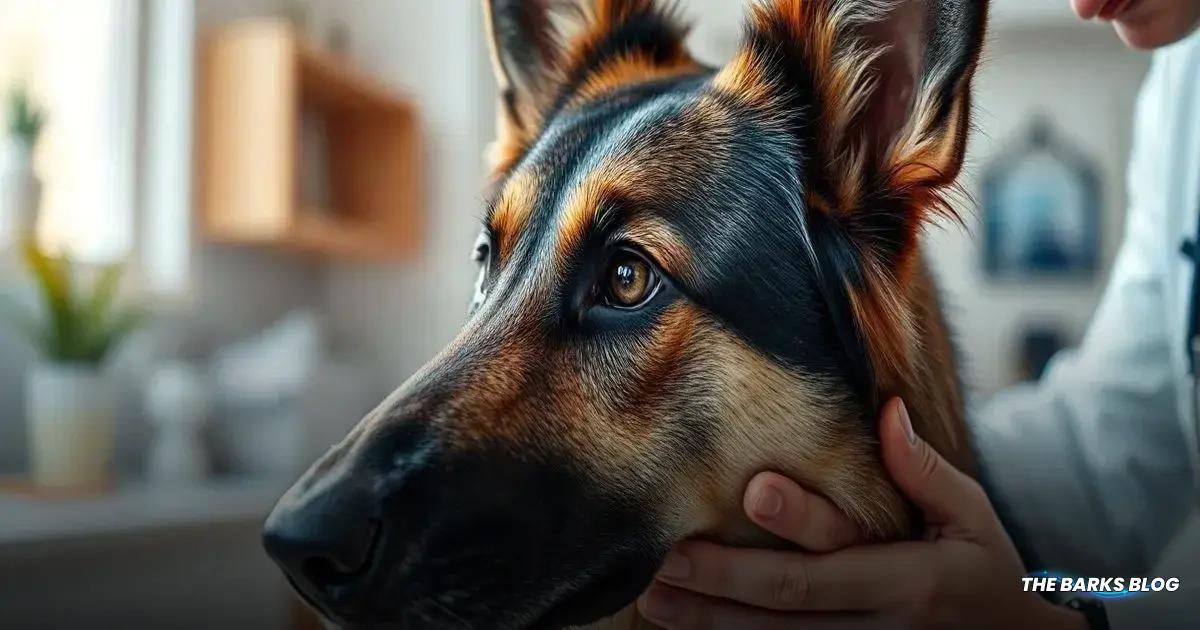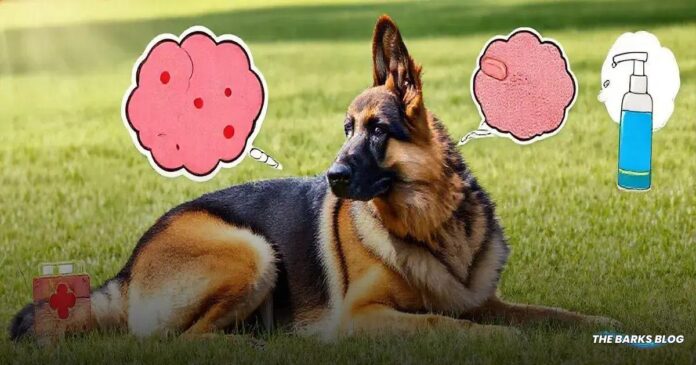German Shepherds are susceptible to skin issues such as allergies, hot spots, mange, pyoderma, and perianal fistulas, which can cause discomfort and health problems. To keep their skin healthy, owners should ensure regular veterinary check-ups, provide a balanced diet, maintain good grooming practices, and prevent parasites. Timely treatment of any skin conditions is crucial for the well-being of your German Shepherd.
German Shepherds are known for their loyalty and intelligence, but they can also face various skin issues. Understanding these problems is crucial for their health.

Common Skin Issues in German Shepherds
Common skin issues in German Shepherds can range from mild itching and irritation to more severe conditions that require prompt veterinary attention. Regardless of the type, many skin problems share similar symptoms, including pruritus (itchy skin), redness, hair loss, sores, bumps, crusting, and changes in odor or texture of the skin.
Dermatitis is a general term for skin inflammation and can occur for various reasons, including allergies, parasites, or environmental factors. German Shepherds are particularly prone to skin issues due to their thick double coat, which can trap moisture and allergens, leading to irritation.
It’s essential for pet owners to monitor their German Shepherds for any signs of skin problems and consult a veterinarian for appropriate diagnosis and treatment. Early intervention can help prevent minor issues from escalating into more serious conditions.

Allergies in German Shepherds
Just like humans, German Shepherds can suffer from allergies, but instead of sneezing, the most common symptom is itchy skin and skin irritation. These allergies can stem from various sources, including:
Environmental allergens: Pollen, dust mites, and other environmental factors can trigger allergic reactions.
Food allergies: Ingredients in their diet can cause adverse reactions, leading to skin issues.
Flea allergies: Flea bites can result in severe itching and inflammation, known as flea allergy dermatitis.
Contact allergies: Materials that come into contact with their skin, like certain fabrics or chemicals, can cause irritation.
German Shepherds tend to have a higher incidence of allergies, especially atopy, which is a genetic predisposition to environmental allergens. Symptoms may include excessive scratching, chewing, or licking of the body, paws, face, and ears. You might also notice redness, inflammation, recurrent ear infections, scabs, or hair loss.
If you suspect your German Shepherd has allergies, it’s crucial to consult your veterinarian to determine the underlying cause and appropriate treatment options. Diagnosing allergies often involves a combination of diet trials, skin tests, and blood tests.
Treatment may include a hydrolyzed protein diet for food allergies, medications like Apoquel or Cytopoint to manage itching, medicated shampoos, and antibiotics if there’s a skin infection. In some cases, allergen-specific immunotherapy (allergy shots) may be suggested to gradually desensitize your dog to specific allergens. Managing allergies is an ongoing process, and finding the most effective treatment plan may take time.

Hot Spots: Causes and Treatments
Hot spots, also known as acute moist dermatitis or pyotraumatic dermatitis, are localized areas of skin inflammation and infection commonly seen in German Shepherds and other dog breeds. These painful lesions can appear suddenly and spread rapidly, often taking on a circular shape and ranging in size from small spots to several inches in diameter.
Hot spots are typically caused by excessive licking, chewing, or scratching at a specific area, often in response to underlying skin irritation due to allergies, pain, or insect bites. The moist environment created by saliva can lead to bacterial infections, worsening the condition.
Treatment for hot spots involves several steps:
- Addressing the underlying cause: Identifying and treating the reason for the irritation is crucial to prevent recurrence.
- Shaving and cleaning the area: This helps to remove any infected or matted hair, allowing the skin to breathe and heal.
- Using an E-collar: An Elizabethan collar can prevent the dog from further licking or scratching the affected area, allowing it to heal properly.
- Topical or oral medications: Your veterinarian may prescribe medications to reduce inflammation and treat any infection present.
It’s essential for pet owners to monitor their German Shepherds for signs of hot spots, as early intervention can lead to quicker healing and prevent more severe skin issues. Regular grooming and maintaining a clean, dry environment can also help reduce the risk of hot spots developing.

Understanding Mange in Dogs
Mange is a common skin condition in dogs caused by microscopic mites that live on or in a dog’s skin. German Shepherds, like many other breeds, can be affected by two primary types of mange:
Demodectic mange: This type is caused by Demodex mites, which are normally present on the skin of dogs. However, in puppies or dogs with weakened immune systems, these mites can multiply, leading to symptoms such as patchy hair loss, redness, scaling, and skin infections.
Sarcoptic mange (scabies): This highly contagious form of mange is caused by the Sarcoptes scabiei mite, which burrows into the skin, causing intense itching, hair loss, and crusty skin. Sarcoptic mange can spread not only between dogs but also to humans.
Diagnosing mange typically involves a veterinarian taking a skin scraping to observe the mites under a microscope. Depending on the severity and type of mange, treatment may include topical and/or oral medications to eliminate the mites. Additionally, some flea and parasite prevention products can effectively treat mange.
It’s essential for pet owners to seek veterinary care if they suspect their German Shepherd has mange, as early diagnosis and treatment can help minimize discomfort and prevent the spread of the condition to other animals or humans.

Common Skin Parasites: Fleas and Ticks
Two of the most common skin parasites affecting German Shepherds are fleas and ticks. Both can cause significant discomfort and lead to serious health issues if not managed properly.
Fleas are small insects that feed on the blood of animals. Their bites can cause intense itching, discomfort, hair loss, and secondary skin infections. Some dogs may develop flea allergy dermatitis (FAD), which is a hypersensitive reaction to flea saliva, resulting in severe itching from even a single flea bite. In severe cases, especially in puppies, flea infestations can lead to anemia due to blood loss.
Ticks are small arachnids that attach themselves to the skin of dogs to feed on their blood. Tick bites can cause inflammation and irritation, and they are also known to transmit various diseases, such as Lyme disease, to both dogs and humans. Regularly checking your German Shepherd for ticks, especially after outdoor activities, is crucial for early detection and removal.
The best way to protect your German Shepherd from fleas and ticks is through veterinary-prescribed prevention methods, which should be used year-round. If you are already dealing with a flea or tick infestation, consult your veterinarian for additional testing and appropriate medications to manage the situation effectively.
Maintaining a clean environment, regular grooming, and using preventative treatments can help keep your German Shepherd free from these pesky parasites and promote overall skin health.

Pyoderma: Recognizing Skin Infections
Pyoderma refers to bacterial skin infections that are quite common in dogs, including German Shepherds. These infections can arise due to a variety of underlying issues, such as allergies, hormonal imbalances, or other skin conditions. Recognizing the signs of pyoderma is essential for prompt treatment and to prevent further complications.
There are two main types of pyoderma:
- Superficial pyoderma: This type often presents with red, itchy skin, pustules (pimples), and hot spots. It typically affects the outer layers of the skin and can be treated relatively easily with appropriate medications.
- Deep pyoderma: This more severe form can cause intense pain, crusting, draining tracts, and significant hair loss. Deep pyoderma often requires more aggressive treatment and may indicate a more serious underlying health issue.
Symptoms of pyoderma may include:
- Redness and swelling of the skin
- Itching and discomfort
- Pustules or sores
- Foul odor from the affected area
- Hair loss or thinning
To diagnose pyoderma, a veterinarian will perform a thorough physical examination and may conduct skin tests, such as cytology (examining skin samples under a microscope) to identify the specific bacteria involved. In some cases, a culture may be necessary to determine the most effective treatment.
Treatment for pyoderma typically includes topical or oral antibiotics, along with medications to manage itching and inflammation. It is crucial to address any underlying conditions, such as allergies or hormonal issues, to prevent recurrent infections. Regular veterinary check-ups and maintaining a healthy skin care routine are vital for keeping your German Shepherd’s skin healthy and infection-free.

Perianal Fistulas: Symptoms and Treatment
Perianal fistulas are a painful condition that is more common in German Shepherds than in many other breeds. These are characterized by draining tracts or tunnels that develop around the anus, often leading to significant discomfort for the affected dog.
Symptoms of perianal fistulas may include:
- Pain, particularly during defecation
- Diarrhea or constipation
- Scooting or dragging the rear end on the ground
- Licking of the anal area
- Bloody or foul-smelling discharge
Due to the sensitive nature of this condition, it’s essential for pet owners to seek veterinary care if they notice any of these symptoms. A veterinarian can perform a thorough examination to confirm the diagnosis and assess the severity of the condition.
Treatment for perianal fistulas often requires a multi-faceted approach:
- Medications: Anti-inflammatory medications and antibiotics may be prescribed to reduce pain and treat any infections present.
- Dietary changes: A high-fiber diet can help facilitate easier bowel movements, reducing strain during defecation.
- Topical treatments: Certain medicated ointments may be recommended to soothe the affected area and promote healing.
- Surgery: In severe cases, surgical intervention may be necessary to remove the affected tissue and alleviate the symptoms.
Managing perianal fistulas can be challenging and may require ongoing veterinary care. Regular check-ups and maintaining a healthy diet and lifestyle for your German Shepherd can help minimize the risk of developing this painful condition.

How to Maintain Healthy Skin in German Shepherds
Maintaining healthy skin in German Shepherds is crucial for their overall well-being. Here are several strategies that pet owners can implement to help keep their dog’s skin in optimal condition:
Veterinary Care
- Regular Check-ups: Schedule annual veterinary exams to monitor your dog’s health and catch any skin issues early.
- Skin Testing: If your German Shepherd shows signs of skin problems, your vet may recommend skin tests, including cytology, skin scrapings, and allergy testing.
- Prompt Treatment: Address any skin issues promptly to prevent them from worsening, which may involve medications or dietary changes.
At-Home Care
- Diet and Nutrition: Feed a balanced diet that meets the WSAVA or AAFCO guidelines to ensure your dog receives all necessary nutrients.
- Regular Grooming: Brush your German Shepherd’s coat several times a week to remove dirt, loose hair, and prevent matting. Bathe them as needed with a gentle dog shampoo to avoid skin irritation.
- Manage Allergies: Work with your vet to identify and manage any allergies your dog may have. This may involve using hypoallergenic products and keeping the home environment clean.
- Parasite Prevention: Use veterinary-recommended flea and tick prevention products year-round to protect your dog from parasites that can cause skin issues.
- Exercise and Enrichment: Ensure your German Shepherd gets plenty of physical and mental stimulation to reduce stress, which can contribute to skin problems.
- Home Remedies: Consult your vet before trying home remedies. Some options, like oatmeal baths and fish oil supplements, may help soothe minor skin irritations.
- Responsible Breeding: If getting a puppy, choose a reputable breeder who practices responsible breeding to reduce the risk of inherited skin conditions.
By following these steps and maintaining regular communication with your veterinarian, you can help ensure your German Shepherd enjoys healthy skin and a happy life.
Conclusion
German Shepherds are wonderful companions, but they are also prone to various skin issues that can affect their quality of life.
By being proactive and understanding the common skin problems they face—such as allergies, hot spots, mange, and infections—pet owners can take the necessary steps to prevent and treat these conditions effectively.
Regular veterinary check-ups, a balanced diet, proper grooming, and parasite prevention are essential components of maintaining healthy skin in your German Shepherd.
Additionally, staying informed about the symptoms of skin issues and seeking prompt veterinary care when needed can make a significant difference in your dog’s health and happiness.
With the right care and attention, you can help your German Shepherd lead a comfortable, active, and fulfilling life, free from the discomfort of skin problems.
FAQ – Common Skin Issues in German Shepherds
What are the common skin issues in German Shepherds?
Common skin issues in German Shepherds include allergies, hot spots, mange, pyoderma, and dry skin.
How can I tell if my German Shepherd has allergies?
Symptoms of allergies in German Shepherds include itchy skin, excessive scratching, chewing on paws, and redness or inflammation.
What are hot spots, and how can they be treated?
Hot spots are localized areas of skin inflammation and infection. Treatment involves cleaning the area, addressing the underlying cause, and using medications to reduce inflammation.
What is mange, and how is it diagnosed?
Mange is caused by mites that live on the skin. It can be diagnosed through skin scrapings examined under a microscope by a veterinarian.
How can I prevent skin infections like pyoderma in my dog?
Prevent skin infections by maintaining a clean and dry environment, managing allergies, and ensuring regular veterinary check-ups.
What should I do if I notice symptoms of skin issues in my German Shepherd?
If you notice symptoms like itching, redness, or lesions, consult your veterinarian promptly for an accurate diagnosis and appropriate treatment.




